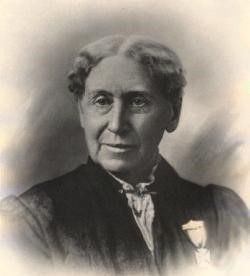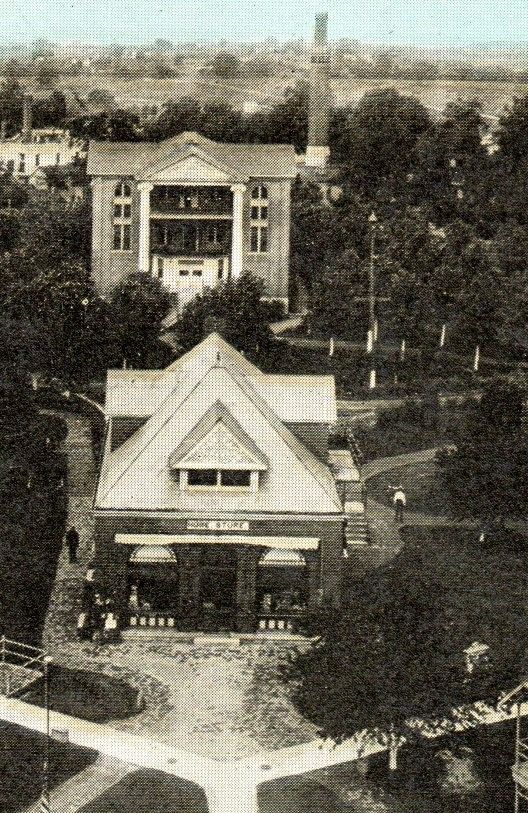John Wood WRC No. 47 of the Woman’s Relief Corps

A notice went out in February 1889, that the seventh annual conference of the Department of Illinois of the Woman’s Relief Corps (WRC) would be held in Quincy on March 12, 1889 at the Trinity Methodist Church on Jersey and Fifth Street. The headquarters would be at the Tremont Hotel on Hampshire. First there would be a Grand Army of the Republic (GAR) parade after which the convention would begin. Annie Wittenmyer, the seventh president of the national WRC was to speak. When the Civil War began in 1861, Wittenmyer was a recent wealthy widow living in Keokuk, Iowa. She spent her time and money in local and statewide aid societies for the war effort traveling to army encampments and military hospitals. After the war, she became the first president of the Woman’s Christian Temperance Union, however her efforts to help wounded soldiers, widows and orphan children never wavered. She lobbied congress for years to get pensions for military nurses and war widows. Pension legislation finally passed in 1892.
The WRC, at the GARs request, was founded in 1883 as an auxiliary for the soldier’s organization. The GAR began in Decatur Illinois in 1886 for the veterans of the Union Army, Navy, and Marines in the Civil War. The first encampment, their term for convention, was in Indiana in 1866 and subsequent yearly encampments were held until 1949. The GAR was more of a fraternal organization and dissolved when the last Civil War veteran died in 1956.
As a charitable organization, the Woman’s Relief Corps is still in existence today. Prior to the WRCs official beginning as an auxiliary for the GAR in 1883, there were various local and statewide relief corps mostly in New England. Their purpose was to provide aid to veterans and their families and also to soldier’s widows and orphan children. Once the WRC became the official auxiliary, the local organizations became chapters and followed GAR rules.
General Orders No. 10 from the headquarters of the Department of Illinois was sent to all the Illinois chapters on February 7, 1889. At that time, the headquarters were in Palestine, Illinois at the far south eastern quarter of the state. The Order No. 10 presented all the details for the conference which was to take place on March 12. Potential delegates were told the Wabash and the C. B. & Q. railroads would only charge a one-way fare for a round trip ticket to Quincy. In order to have a delegate credentialed and seated at the conference, each chapter had to send in quarterly reports and election results. The conference planners hoped that a delegate from all 148 chapters in Illinois would be represented at the conference.
The order also listed the hotel rates at Quincy. The Newcomb at $2.50 to $3.00 per day was the highest followed by The Tremont and The European at $2.00 to $2.50 per day. The last three listed hotels, The Hickman, The Occidental, and the Franklin were $1.00 to $1.50 per day.
The February 22, 1889 Quincy Daily Whig, boasted about Quincy saying, “The simple fact of the matter is Quincy has a widespread reputation for hospitality and people who visit the city once are usually pleased to come again. … It is known as a wide awake, progressive place, a city which is enjoying a genuine boom. Now that we have sufficient hotel accommodations …there will be little difficulty in securing a fair proportion of the large annual gatherings held in the state.” The quote was in the middle of an article mentioning that the GAR and the Sons of Veterans were also holding their annual meetings during the same week as the WRC.
The 1880s saw the largest growth of the WRC. Most cities and even small towns in the country had chapters. One universal problem was finding a meeting room large enough for the group. The GAR experience the same issue and according to an April 18, 1886 article in the Quincy Daily Whig, They suggested that the Free Reading Room Association and the GAR join together to build a building for both organizations. They assumed that “the Woman’s Relief Corps embracing so many ladies of experience to sanitary work and the duties of the Needle Pickets during the war, would find means to make the movement a success if the efforts of the gentlemen failed.”
Quincy’s WRC chapter, named the John Wood WRC No. 47, was very active and participated in the various activities that surrounded the opening of the Soldiers and Sailors Home, now the Illinois Veterans Home, in October of 1886. Today it is the largest and oldest veterans’ home in Illinois.
During the October opening celebration, the WRC served meals all three days in a tent on the grounds, with the proceeds dedicated to the Civil War widows and orphans. According to the October 22, 1886 Quincy Daily Whig, “Precisely at 3 o’clock the Woman’s Relief Corps fell in line behind the cannon, and Mrs. Myra Fenton fired the gun that proclaimed to all that the grandest and most enthusiastic celebration ever held in Illinois had come to an end.”
In 1896, the Quincy chapter of the Woman’s Relief Corps presented a resolution to the Department of Illinois Annual Convention asking for support for a memorial cottage be built at the Veteran’s Home in Emily Lippincott’s memory. Charles Lippincott was the first superintendent of the Home and Emily, who came to be known as Mother Lippincott, devoted her life to the care and comfort of the veterans. The cottage was to house women visiting their loved ones. The WRC raised money, but the cottage was not built. Instead, a memorial hall was built which survived two fires until it was torn down and replaced. The current Lippencott Hall is dedicated to the memory of Charles and Emily.
Sources
“A Memorial Hall.” Quincy Daily Whig, April 18, 1886, 6.
“Attention Comrades.” Quincy Daily Journal, June 5, 1885, 4.
“Brevities.” Quincy Daily Whig, August 16, 1884, 8.
“Coming to Quincy.” Quincy Daily Whig, February 22, 1889, 4.
“For Soldiers Widows’ and Orphans.” Quincy Daily Whig, September 25, 1886, 3.
“The Last Day.” Quincy Daily Whig, October 22, 1886, 3.
Snyder, Lynn. “Of Dueling and Service, the Story of Charles and Emily Lippencott.” Quincy Herald Whig,
January 5, 2014.
“Woman’s Relief Corps (U. S.) Dept. of Illinois.” F834.17.129 Abraham Lincoln Presidential Library.







